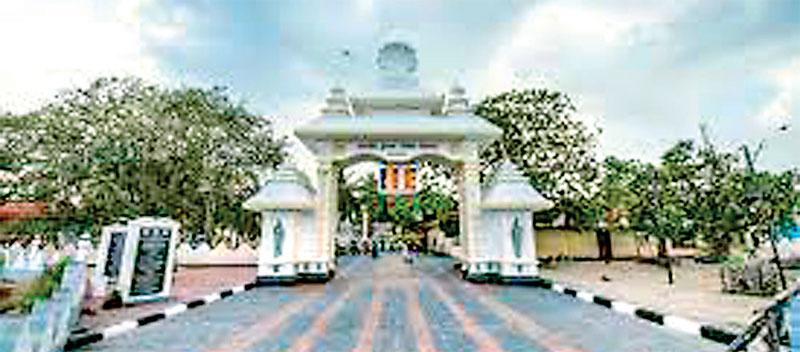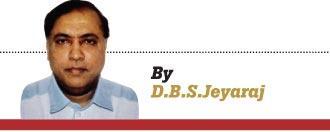19 Aug 2023 - {{hitsCtrl.values.hits}}

 The conduct and pronouncements of some prominent Sinhala Buddhist monks have in recent times contributed greatly towards the deterioration of inter-ethnic amity and inter-faith relations in this country. It is indeed a matter of grave concern that the “antics” of these “patriotic” Buddhist monks have created a very negative image of the Buddhist clergy among the Island’s non -Buddhists in general and North-eastern Tamils in particular.
The conduct and pronouncements of some prominent Sinhala Buddhist monks have in recent times contributed greatly towards the deterioration of inter-ethnic amity and inter-faith relations in this country. It is indeed a matter of grave concern that the “antics” of these “patriotic” Buddhist monks have created a very negative image of the Buddhist clergy among the Island’s non -Buddhists in general and North-eastern Tamils in particular.
The disproportionate coverage provided by sections of the mainstream media to these politicised Bhikkus has created an impression that the Buddhist clergy in Sri Lanka is totally opposed to the Tamil people.
This negative perception is not true. There have been many Buddhist Monks who interacted amicably with the Tamil people in a spirit of friendship and goodwill. The members of the Buddhist clergy who rarely got involved in politics earned the trust, respect and devotion of the Tamil people with whom they enjoyed a cordial relationship.
It is in this context therefore that this column focuses this week on a Buddhist Prelate from the ‘Sinhala South’ who was much loved by the Tamil people in a Northern Island.
I am of course referring to the Venerable Brahmanawatte Dhammakiththi Tissa Mahanayaka Thera, the former Viharadhipathi of the Nagadeepa Raja Maha Vihara in Jaffna.
The respected Mahanayake Thera who was the Nagadeepa Viharadhipathy for 55 years, passed away on April 15, 2003. This year marks the 20th death anniversary of the beloved Buddhist prelate who was adored by the Tamil people of the northern Island known in Tamil as Nainatheevu.
The Ven. Brahmanawatte Dhammakithi Thera passed away at the Colombo National Hospital on April 15 2003 which incidentally was the day of his birth too. The 88-year-old prelate had been ailing for some time. Even though his funeral could have been held in Colombo or his native place Balapitiya, the remains of Venerable Rajakeeya Panditha Brahmanawatte Dhammakithi Tissa Mahanayaka Thera, the Chief Incumbent (Viharadhipathi), Nagadeepa Purana Raja Maha Viharaya were cremated under state patronage on 21 April 2003 at the Adahana Maluwa of the Nagadeepa Viharaya.
This was in deference to the preponderant wishes of the people of Nainatheevu or Nagadeepa. This was indeed appropriate because the Mahanayake Thera had spent an unbroken 55 years in Nainatheevu.
Vast crowds comprising clergy and laity of all four major religions in the country attended the funeral. The people of Nainatheevu fittingly paid their tribute and also as a token of their esteem showered hospitality on all the mourners who gathered in the small northern island.
Although I am not from Nainatheevu I was quite sad when I heard of the venerable priest’s demise 20 years ago. I had first seen him when first touring the island as a child with my family. Later I met him on a few occasions when visiting with friends in Nainatheevu.
I had also met him accompanying Sinhala friends from the south as an unofficial guide. The most treasured memory of the prelate is a lengthy discussion and brief interview I had with him in 1981 when I was acting for some months as the northern correspondent of the Virakesari.
The Nagadeepa Mahanayake Thera was truly a remarkable man who blended with his surroundings and established a vibrant relationship with the people of the area. He was a true disciple of Lord Buddha because he did not play ‘politics’ in any way and was only concerned with preaching the dhamma and maintaining a Buddhist presence on an island associated in belief with the Buddha.
|
Ven. Brahmanawatte Dhammakiththi Tissa Mahanayaka Thera
|
BRAHMANAWATTE, BALAPITIYA
This Mahanayaka Thera of the Amarapura Mulawanshika Nikaya was born in Brahmanawatte, Balapitiya on April 15, 1915. His parents were Migalahandige Richard de Silva and Lakdu Layanhamy who decided to admit their youngest son to the Sasana. Accordingly the “Podi Putha” entered the Bhikkhu Order under Thotagamuwe Pagnamoly Tissa Nayaka Thera at Ambalangoda Randombe Maha Chetiya Pirivena.
He completed his studies at the same Pirivena obtaining the Pracheena Pandit degree in Sinhala, Pali and Sanskrit.
He also passed his London matriculation along with his erudite contemporary, Venerable Professor Walpola Rahula Thera.
In 1939 the Balapitiya Buddhist monk went to Jaffna and joined Victoria College at Chulipuram. (The alma mater of Tamil political leader Appapillai Amirthalingam).
The Thera taught Sinhala while learning English literature and Tamil there. He became very proficient in Tamil and later wrote many books and booklets on Buddhism in that language. Chief among them was “Puthar Vanakkam”. Vanakkam’ was very much popular among Tamils.
Among his writings in Sinhala are ‘Uthure Nagadeepaya’, ‘Seema Lakkhana Deepani’, “Solos Maha Than” and ‘Prakrutha Prakasha Vyakyawa”.
It was while teaching at Victoria College that he became associated with the Nagadeepa Vihare. The Chief Incumbent of the Nagadeepa Vihara then was the Ven. Randombe Somasiri Tissa Thera. The Ven. Dhammakitti Tissa Nayaka Thera began assisting Randombe Somasiri Thera at the Vihare.
He spent three days a week at Chulipuram and four days in Nainatheevu. After the demise of Somasiri Tissa Thera, Dhammakitti Tissa Nayaka Thera succeeded him as Nagadeepa Vihara Chief Incumbent in 1948.
The Sinhala Bhikku hailing from Balapitiya became a permanent resident of the Tamilspeaking Nainatheevu Island.
NAINATHEEVU/NAGADEEPA
The Nainatheevu island has an area of nearly six square miles. Known as Nagadeepa in Sinhala the island - along with Kelaniya and Mahiyangana - is believed to be one of the three places in Sri Lanka that Lord Buddha visited.
The present Raja Maha Vihara was re-constructed mainly due to the efforts of Dhammakithi Mahanayake Thera. It was not built on property acquired or seized by the State.
Instead, it was purchased at a very nominal sum from the people of the area. These families belonged to the Thimilar - fishing sub-caste.
As a result of this Ven. Dhammakiththi had a special affinity towards Nainatheevu fisherfolk. He was like a guardian angel to them and prevented them from being harassed by the naval detachment stationed there.
There are many instances testifying to the humanity of the prelate. For want of space, I will relate three important ones.
1958
In 1958 there was no Naval post on the island. When the communal violence erupted the Navy personnel at Karainagar in a precautionary move, evacuated the Mahanayake Thera to the Naval base there.
Although the people of Nainatheevu remained peaceful there were a number of people from adjacent islands engaged in trading in the south.
Many were affected and were compelled to return home. Some of these people got excited and became a frenzied mob.
They converged on Nainatheevu and attacked the vihara in the absence of the priest. The ancient statue of the Buddha was destroyed by the mob. Had this news spread in the south passions would have been aroused more and led to further escalation of violence.
But the then Governor-General Sir Oliver Goonetilleke suppressed the information.
Urgent measures were taken to get down an identical statue from Myanmar (Then Burma.) It was brought as a replacement. To his eternal credit, Ven Dhammakiththi went along with this ‘exercise of deception’ in the interest of humanity.
This substitution remained a secret until Tarzie Vittachi revealed it in his book Emergency 58. Also, the Karainagar Navy Camp later rounded up a number of Nainatheevu people as suspects.
The priest however insisted that all be released.
1986
The second incident was in 1986. Nainatheevu had been free of militant violence for a long. But then two Tiger recruits from the island laid underwater explosives along the jetty. The wires extended underwater to Kurikadduvaan.
Lying in wait there the LTTE men observed Nainatheevu with binoculars. When a Naval patrol launch reached the jetty the explosion was set off.
Fortunately for the Navy, it went off prematurely.
The pier was destroyed but the Naval personnel escaped. The enraged sailors embarked on a shooting spree targeting innocent civilians.
The Ven. Dhammakiththi accosted them and flung off his robes saying that he as a Buddhist priest could not tolerate such a sin. The Navy men calmed down and returned to the barracks. A large-scale massacre was averted.
1990
The third was in 1990. Nainatheevu has a small Muslim population too. In fact, there is a belief that the island derived its name from a well-known Muslim merchant Naina Muhammad who leased the island from the Sethupathy Kings of Ramnad in India.
The LTTE after evicting Muslims from the peninsula wanted to drive the Nainatheevu Muslims too.
The Muslims sought asylum with Ven. Dhammakiththi. The Buddhist prelate ensured that adequate protection was given to them by the Navy.
He also told the LTTE bluntly that no Muslim would be sent away. The Muslims of Nainatheevu are the only Muslims who continued to remain Jaffna despite the Tiger expulsion.
AMMAN TEMPLE
The Amman temple chariot festival days and Poson usually overlapped. Ven Dhammakiththi had a lavish feast offering (Madai Paravuthal) at the Vihara during the water-cutting ceremony. Later this practice was extended to the Veerapathirar Temple ceremony too. During Vesak season there was a Dansala that catered more to Tamils than Sinhala people.
Buddhist devotees often bring sweets, biscuits and chocolates to be given to the Mahanayake. The Ven. Dhammakiththi would take them personally in rotation to the gates of the three schools on the island and distribute them amongst the children.
FIRST DONATION
The Buddhist prelate was also a financial tower of strength to the people. He would lend them money whenever required, often getting the money from others to help those in urgent need.
Whenever the people of Nainatheevu organised a cultural event they would first go to the Buddhist priest for the first donation. In spite of this intimate intermingling Ven. Dhammakiththi never engaged in politics. He remained aloof never attending political meetings, though he would participate in literary meetings.
At the time of his passing, the Mahanayake Thera had four disciples. They were the Ven Brahmanawatte Seevali Thera, Ven. Balabowe Wimalakiththi Thera, Ven. Kadawatha Vijitha Thera and the Ven. Navandagala Padumakiththi Thera.
Of these Sivali Thera is no more. Wimalakithi Thera is ailing and has “retired “to his ancestral abode in Kurunegala. Vijitha Thera has disrobed. The fourth disciple Ven. Navadagala Paduma Kitthi Tissa Nayaka Thera is now the Chief incumbent of the Vihara.
SINNA SAMY
Padumakithi Thera came to Nainatheevu at the age of 11. He was for long called the “Sinna Samy (Junior Priest) while Dhammakiththi Thera was called Periya Saamy (Senior Priest). Padumakiththi, who grew up in Nainatheevu continues the great tradition set by Dhammakiththi Thera.
The people of Nainatheevu are now scattered in different countries in Europe and North America. The Present Nagavihara Mahanayake maintains contact with them and often undertakes overseas trips.
Whenever he does so the Nainatheevu Diaspora meet him and pay their respects.
A few years ago Padumakiththi There attended the wedding of Canada Eelanaadu Newspaper T.K. Parameswaran in Toronto.
The Thera and the Editor are boyhood friends. Most of the guests who were from Nainatheevu were glad to see their former Sinnasamy and kept taking photographs and selfies.
50TH ANNIVERSARY
On July 8th this year, Padumakiththi Thera celebrated the 50th anniversary of his arrival in Nainatheevu. A grand celebration was organized by the people of Nainatheevu to felicitate him. Representatives of all four Nikayas were present at the function.
May the glorious tradition of Southern Buddhist Monks living in Northern Nainatheevu Island flourish forever!
D.B.S.Jeyaraj can be reached at [email protected]
25 Nov 2024 7 hours ago
25 Nov 2024 8 hours ago
25 Nov 2024 8 hours ago
25 Nov 2024 25 Nov 2024
25 Nov 2024 25 Nov 2024